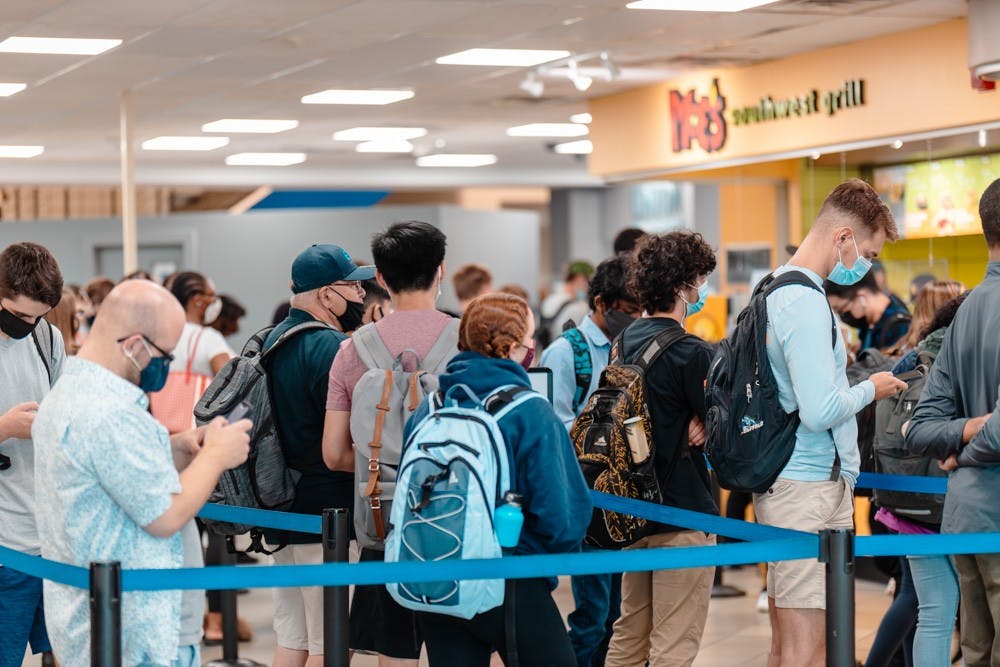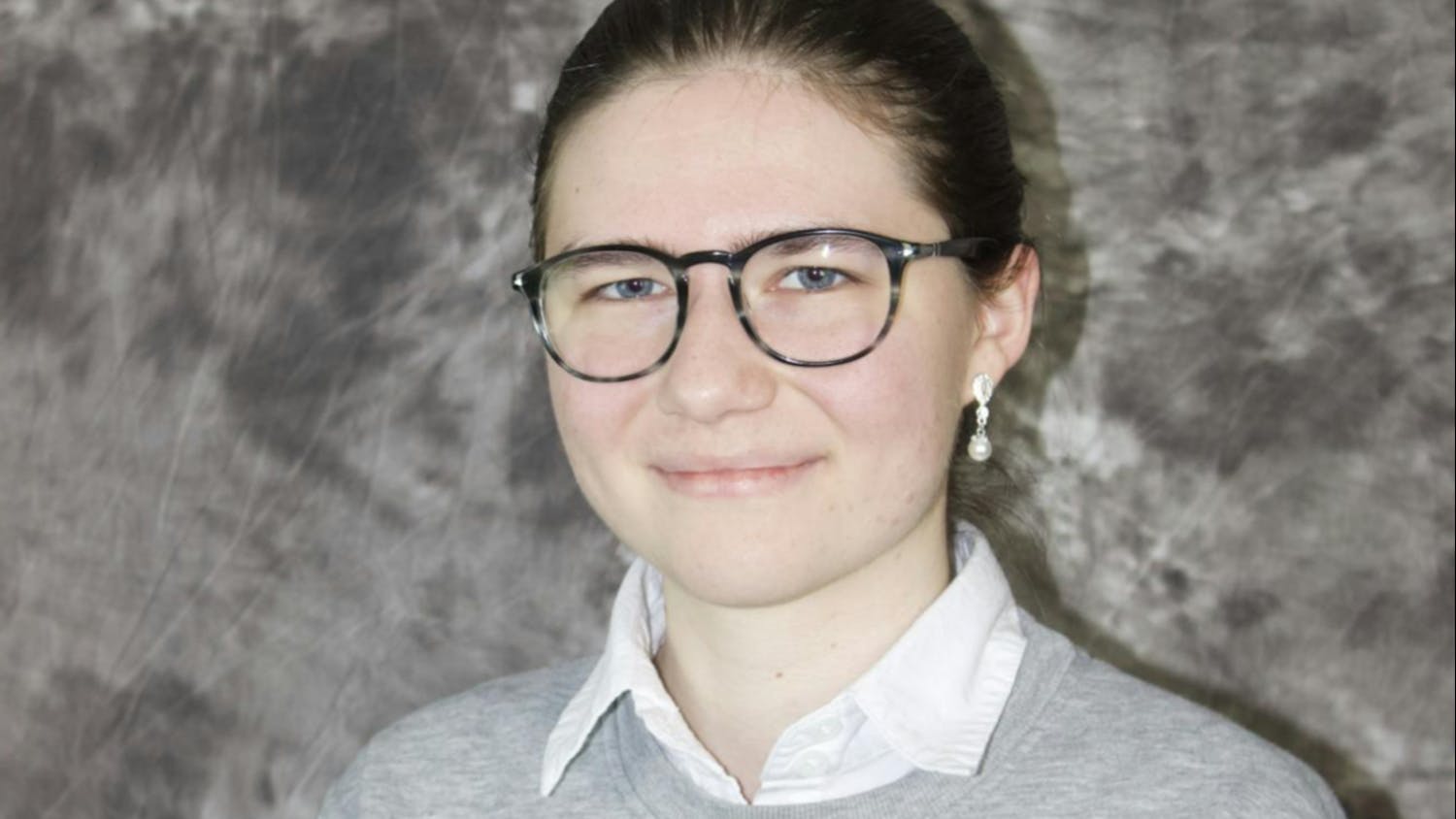Despite leaving her dorm 30 minutes before her lecture to get breakfast at 8:30 a.m., freshman biomedical sciences major Dina Dahhan had to settle for a partly frozen Smucker’s Uncrustables sandwich from the vending machine.
That’s because the long lines at various eateries in the Atrium would have made her late for class.
Dahhan isn’t the only student who has been forced to make unorthodox meal choices this past week. The national labor shortage has made it difficult for Campus Dining and Shops to meet student demand, resulting in the temporary closure of Atrium eateries, Hubies and The Bowl. The long wait times and limited hours are making it difficult for students to use their meal plans — despite the price increase on all student meal plans over the summer.
Matthew Malles, a junior business administration major, is one of the students feeling a crunch.
“Despite the meal plan cost increasing, there are less available options for students to eat at,” Malles said in an interview with The Spectrum. “The places that are open [are] experiencing far more crowds than before.”
CDS attributes the congestion to the national labor shortage, but also to a backlog from the Social Security Administration, which processes paperwork required for international students to work in the U.S. International students make up a large part of CDS’s workforce, so once the paperwork is pushed through, CDS hopes more food services will be available.
“Campus Dining and Shops and UB, with the help of Sen. Chuck Schumer’s office, have worked to rectify this situation for our students, which will allow them to begin work within our food service operations,” Campus Dining and Shops marketing and communications director Raymond Kohl wrote in an email. “An influx of new employees will help to significantly reduce the wait times and hopefully enable us to reopen dining locations.”
According to Kohl, Hubie’s and The Bowl will remain closed indefinitely.

Hubie’s is known for its pizza, wings, subs and other American fare, while The Bowl is one of the few places on campus that offers a variety of salads and hot veggie bowls.
Other on-campus locations include Tim Hortons, Jamba Juice, Moe’s, Champa Sushi, the Union Marketplace & Eatery and Pistachio’s in the Student Union; North Campus’ Capen Café; and South Campus’ Harriman Cafe. All of these eateries close at 7 p.m. or earlier Monday through Friday, with the exception of Tim Hortons, which closes at 8 p.m. during the week.
As long lines continue to disrupt on-campus dining, some students have turned to alternative sources outside of their meal plans, including buying food off campus or at the Commons. For some students, this means multiple unused meal swipes at the end of the week. In some cases, some have doubled up on meal periods, buying multiple meals at once.
“Me and my roommates are freshmen and we haven’t been able to get through our meal swipes at all so far,” Anthony Giorgio Sacchetti, a psychology major, said. “I’ve found myself trying to use two swipes whenever I can at a restaurant just to try and keep up.”
Giorgio Sacchetti isn’t the only one trying to put his swipes to use.
“Last week I had 10 extra meals that went to waste,” Katie Cowen, a freshman exercise science major, said about her first week on campus. “We got here on Tuesday, and then one of the days we couldn’t get reservations [at the dining hall] and went off campus.”
Cowen is referring to another issue possibly driving lines at the Atrium and other eateries — limited access to campus dining halls. Due to COVID-19 restrictions, students must make reservations to eat in popular dining halls like C3. However, with limited spots available, students are often unable to find open slots, leaving dining areas like the Atrium their only source for meals.
Rather than travel off campus like Cowen, other students have tried to beat the lines by ordering ahead on the GET app, but even this has had its share of problems.
“At Sizzles, I was trying to order [at] around 6 p.m., and it was a pretty small order,” sophomore English education major Alex Novak said. “But I got a message from the GET app saying they were at order capacity and they weren’t taking any more orders.”
According to UB’s dining website, Sizzles is open until 10:30 p.m, Monday through Friday.
The GET app, which allows students to order food ahead from on-campus eateries, is one of two online platforms students can take advantage of for their meal plans. UB also supports Nutrislice, which only allows for making reservations at a dining hall, a function also supported by the GET app.
Some students say learning how to use the two apps has been a challenge. During their first week, some were not aware that they needed to manually switch from dining dollars to meal swipes when making reservations in the Nutrislice app.
“We had no idea the difference between our dining dollars and our meal swipes,” Cowen said. “I used my dining dollars all the time. I’m already down $50.”
CDS says it feels students are adequately prepared to navigate the GET and Nutrislice apps.
“In rolling out the new Nutrislice app, email, social media, on-site signage were utilized as well as having support staff available on site to walk students through the download and how to make reservations during the opening week.” Kohl said. “With no in-person orientation sessions again this year, the GET app was included in the online session of orientation and in the student check-list of things to do before arriving on campus.”
Strained dining services from the labor shortage are not unique to UB. Campuses across the nation are having trouble recruiting new employees. Student newspapers The Breeze and Vidette also reported limited on-campus dining services because of labor shortages at James Madison University and Illinois State University, respectively.
While many are feeling underserved, others have been understanding of the nationwide dynamics at play. Despite eating PB&J for breakfast, Dahhan expressed understanding of the problems CDS is facing.
“I understand it’s not their fault,” Dahhan said. “But it’s definitely less convenient.”
Natalie Doller is an assistant news/features editor and can be reached at natalie.doller@ubspectrum.com
Kara Anderson is the assistant arts editor and can be reached at kara.anderson@ubspectrum.com

Kara Anderson is a senior arts editor at The Spectrum. She is an English and Spanish double major and is pursuing a certificate in creative writing. She enjoys baking chocolate chip cookies, procrastinating with solitaire and binging reality TV on the weekends.





